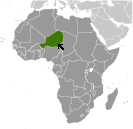World Atlas: Niger. On this page you can see the map, country flag and many detailed information about the people, history and economy of Niger.

Here you can find online selected information about the geography, inhabitants, government, economy and history of Niger. Included are selected statistics, an overview map and the detailed map of Niger. But let's start with the flag of Niger here:
Niger - Overview:
What you should know about Niger? Let's start with this: Niger became independent from France in 1960 and experienced single-party and military rule until 1991, when Gen. Ali Saibou was forced by public pressure to allow multiparty elections, which resulted in a democratic government in 1993. Political infighting brought the government to a standstill and in 1996 led to a coup by Col. Ibrahim BARE. In 1999, BARE was killed in a counter coup by military officers who restored democratic rule and held elections that brought Mamadou Tandja to power in December of that year. Tandja was reelected in 2004 and in 2009 spearheaded a constitutional amendment allowing him to extend his term as president. In February 2010, military officers led a coup that deposed Tandja and suspended the constitution. Issoufou Mahamadou was elected in April 2011 following the coup and reelected to a second term in early 2016. Niger is one of the poorest countries in the world with minimal government services and insufficient funds to develop its resource base. The largely agrarian and subsistence-based economy is frequently disrupted by extended droughts common to the Sahel region of Africa. A Tuareg rebellion emerged in 2007 and ended in 2009. Niger is facing increased security concerns on its borders from various external threats including insecurity in Libya, spillover from the conflict in Mali, and violent extremism in northeastern Nigeria.
Geography of Niger
 Where on the globe is Niger? The location of this country is Western Africa, southeast of Algeria. Total area of Niger is 1.267 million sq km, of which 1,266,700 sq km is land. So this is very large country. How could we describe the terrain of the country? This way: predominately desert plains and sand dunes; flat to rolling plains in south; hills in north. The lowest point of Niger is Niger River 200 m, the highest point Idoukal-n-Taghes 2,022 m. And the climate is desert; mostly hot, dry, dusty; tropical in extreme south.
Where on the globe is Niger? The location of this country is Western Africa, southeast of Algeria. Total area of Niger is 1.267 million sq km, of which 1,266,700 sq km is land. So this is very large country. How could we describe the terrain of the country? This way: predominately desert plains and sand dunes; flat to rolling plains in south; hills in north. The lowest point of Niger is Niger River 200 m, the highest point Idoukal-n-Taghes 2,022 m. And the climate is desert; mostly hot, dry, dusty; tropical in extreme south.
Inhabitants of Niger
Let's take a look how many people live in Niger. The number is: 19,245,344 (July 2017 est.). So this is not very populous country. Who lives here? Hausa 53.1%, Zarma/Songhai 21.2%, Tuareg 11%, Fulani (Peul) 6.5%, Kanuri 5.9%, Gurma 0.8%, Arab 0.4%, Tubu 0.4%, other/unavailable 0.9% (2006 est.). What are the languages in Niger? French (official), Hausa, Djerma. And the religions: Muslim 80%, other (includes indigenous beliefs and Christian) 20%. How old are the people in average? 15.4 years. We have to add that this number is the median - so one half of the people is older than this, one half is younger. And what is their life expectancy (at birth)? This: 55.9 years. Where the people live in Niger? Here: majority of the populace is located in the southernmost extreme of the country along the border with Nigeria and Benin. The major urban areas of Niger are: Niamey (capital) 1.09 million (2015).
Government and Economy of Niger
The capital of Niger is Niamey and the government type semi-presidential republic. Let's take a look at the administrative divisions - 7 regions (regions, singular - region) and 1 capital district (communaute urbaine); Agadez, Diffa, Dosso, Maradi, Niamey, Tahoua, Tillaberi, Zinde. Regarding the economy of Niger, important industrial products are uranium mining, petroleum, cement, brick, soap, textiles, food processing, chemicals, slaughterhouses. Important agricultural products are cowpeas, cotton, peanuts, millet, sorghum, cassava (manioc, tapioca), rice; cattle, sheep, goats, camels, donkeys, horses, poultry. The most important export commodities are uranium ore, livestock, cowpeas, onions and the most important export partners are France 31.3%, Thailand 11.6%, Malaysia 11.1%, Nigeria 9.5%, Mali 5.6%, China 5.3% (2016). The most important import commodities are foodstuffs, machinery, vehicles and parts, petroleum, cereals and the most important import partners are France 28.3%, China 16.1%, US 7.8%, Nigeria 5.8%, Thailand 5.8% (2016). How rich is Niger and how rich are people in this country? The most important number here is GDP per capita (PPP): $1,200 (2017 est.). This is a very low number. Let's add that this means Gross Domestic Product per person, which is recalculated with respect to the relative cost of local goods and services. And one more important number - population below poverty line: 45.4% (2014 est.).